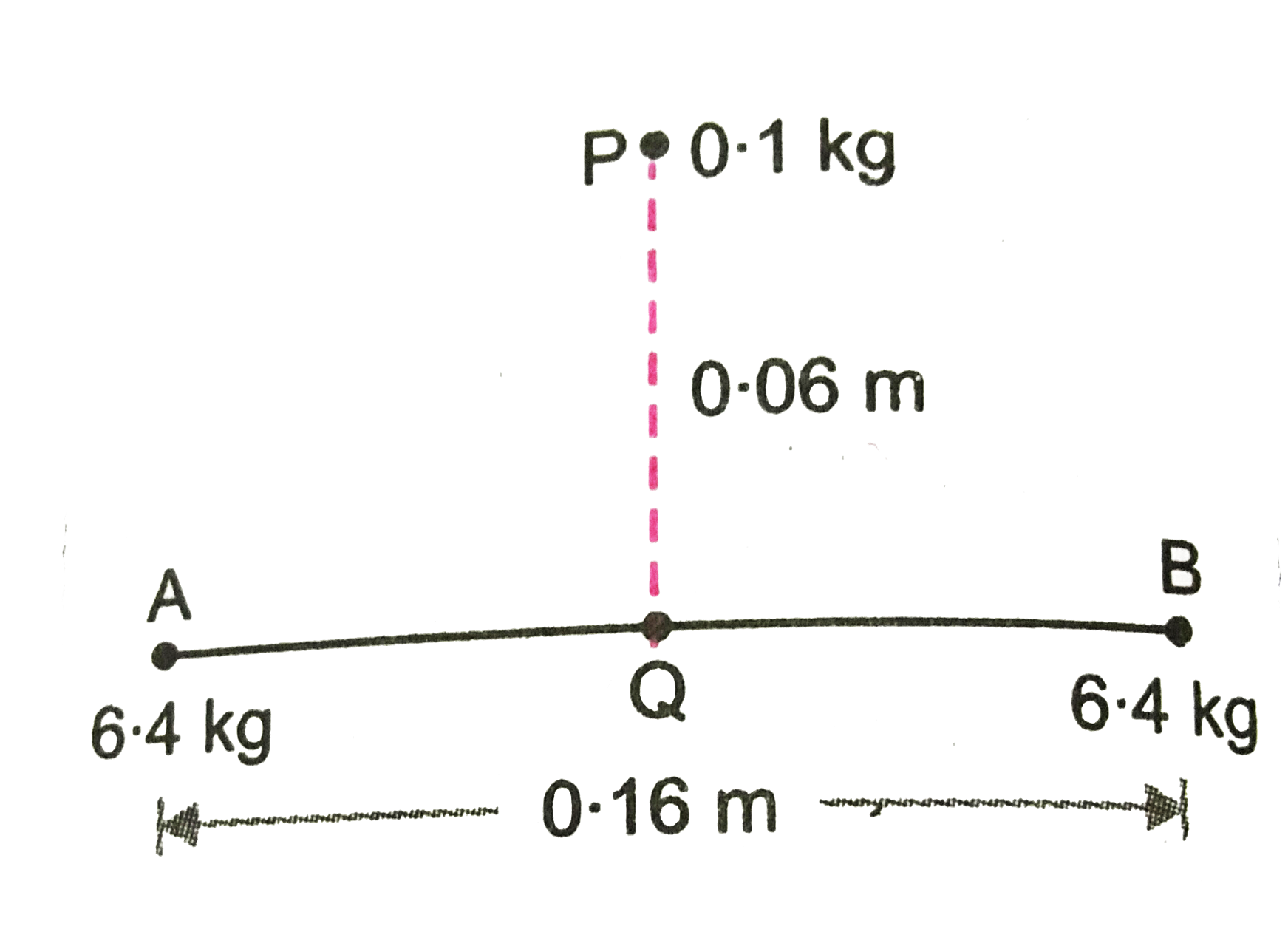Two equal masses of 6.40kg are separted by a distance of 0.16m. A small body is released from a point P, equidistant from the two masses and at a distance of 0.06m from the line joining them. Fig.
(a) Calculate the velocity of this body when it passes through Q.
(b) Calculate the acceleration of this body at P and Q if its mass is 0.1kg.
Use G=6.67×10−11Nm2kg−2

In figure, AP=BP=√(0.08)2+(0.06)2=0.1m
Here, m1=6.4kg=m2 and m3=0.1kg
(a) When body falls from P to Q, then gain in KE of body is equal to loss in PE of the system.
∴12m3υ2=−[Gm1m3(0.1)+Gm2m30.1]
+[Gm1m30.08+Gm2m30.08]
or 12υ2=−[Gm10.1+Gm20.1]+[Gm10.08+Gm20.08]
or υ2=−2×G[(6.40.1+6.40.1)−(6.40.08+6.40.08)]
=−2×(6.67×10−11)×(−32)
=64×6.67×10−11
or υ=(64×6.67×10−11)1/2=6.53×10−5ms−1
Topper's Solved these Questions
- GRAVIATIONBOOK - PRADEEPCHAPTER - GRAVIATIONEXERCISE - NCERT
21 Videos
- GRAVIATIONBOOK - PRADEEPCHAPTER - GRAVIATIONEXERCISE - ADDITIONAL EXERCISES
4 Videos
- GRAVIATIONBOOK - PRADEEPCHAPTER - GRAVIATIONEXERCISE - LONG ANSWER QUESTIONS
11 Videos
- BEHAVIOUR OF PERFECT GAS & KINETIC THEORYBOOK - PRADEEPCHAPTER - BEHAVIOUR OF PERFECT GAS & KINETIC THEORYEXERCISE - Assertion - Reason Type questions
14 Videos
- KINEMATICSBOOK - PRADEEPCHAPTER - KINEMATICSEXERCISE - 1 NCERT Comprehension
4 Videos
Similar Questions
Two equal masses of 6.40kg are separated by a distance iof 0.16m.. A small body is released from a point P, equivalent from the two masses and at a distance of 0.06m from the line joining them as shown in Fig.913 (i) Calculate the velocity when it passes through Q. (ii) Calculate the accleration of this body at P and Q if its mass is 0.1kg.
View SolutionA body of mass 25 kg has a momentum of 125 kg.m/s. Calculate the velocity of the body.
View Solution
Knowledge Check
Two bodies of masses 10 kg and 100 kg are seperated by a distance of 2 m. The gravitational potential at the mid-point of the line joining the two bodies is:
A−7.3×10−7J/kgB−7.3×10−8J/kgC−7.3×10−9J/kgD−7.3×10−6J/kgTwo partcles of masses 1 kg and 2 kg are placed at a distance of 3 m. Moment of inertia of the particles about an axis passing through their centre of mass and perpedicular to the line joining them is (in kg−m2)
A6B9C8D12Two point masses m and M are separated bya distance L . The distance of the centre of mass of the system from m is
AL(m/M)BL(M/m)CL(Mm+M)DL(mm+M)
Two masses 600 kg and 800 kg are separated by a distance of 0.2 m. What will be te magnitude of the intensity of the gravitational field at a point distant 0.16m from the 600 kg mass and 0.12 from the 800 kg mass.
View SolutionTwo bodies of masses 10 kg and 1000 kg are at a distance 1 m apart. At which point on the line joining them will the gravitational field-intensity be zero ?
View SolutionTwo point masses m and M are separated by a distance L . The distance of the centre of mass of the system from m is
View SolutionTwo bodies of masses m1 and m2 are separated by a distance R. The distance of the centre of mass of the bodies from the mass m1 is
View SolutionTwo bodies of masses m1 and m2 are separated by a distance R. The distance of the centre of mass of the bodies from the mass m1 is
View Solution
